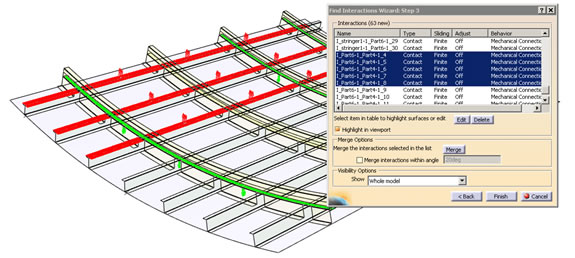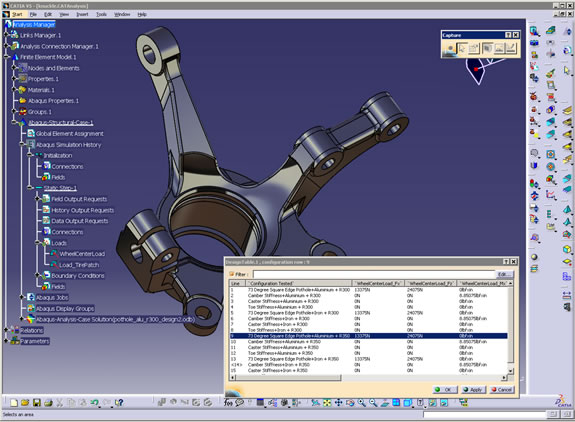Latest News
September 26, 2007
By Anthony J. Lockwood
Dassault Systemes’ (DS; Paris, France) SIMULIA (Providence, RI; ) recently released Version 2.5 of Abaqus for CATIA V5. This latest version is said to improve realistic product behavior simulation during the design phase by offering more productivity and an even easier-to-use interface. SIMULIA says it hopes it instills confidence during product development while minimizing software interfaces.
 |
Abaqus for CATIA V5 brings Abaqus finite element analysis (FEA) technology into the CATIA V5 user environment. CATIA V5 provides design capabilities and Abaqus for CATIA V5 makes the design model and the simulation model one and the same, bringing power and flexibility to the engineer’s desktop. The result is a complete package for deploying proven FEA-based simulation throughout the design process.
The new release, Version 2.5, available on the latest 64-bit computing architecture as well as 32-bit systems, provides tighter integration with CATIA V5 through support of CATIA Knowledgeware, publications, and sensors, as well as such improvements as automatic contact detection. These are some of what’s new since Desktop Engineering covered Version 2.4 in in a news item in December 2006 (“ABAQUS 2.4 for CATIA V5 Released”).
Input from global leaders in the automotive and aerospace industries helped set the development direction for Abaqus for CATIA V5 (AFC) by specifying and evaluating new features. Thus, AFC tackles a range of high-value workflows without leaving CATIA V5. Automation and scripting tools open AFC to customization and additional efficiencies for scenarios performed on a regular basis.
“This release is a key component of our strategy to deliver solutions that enable design engineers and expert analysts to collaborate efficiently throughout the product lifecycle by using approved methods, common FEA models, and synchronized data,” said Steve Crowley, director of SIMULIA product management for Dassault Systemes in a press release.
| “This release is a key component of our strategy to deliver solutions that enable design engineers and expert analysts to collaborate efficiently throughout the product lifecycle by using approved methods, common FEA models, and synchronized data.” —Steve Crowley, |
The new product leverages CATIA’s Knowledgeware, which allows users to capture design knowledge and reuse it as best practices to ensure compliance with established standards. Plus, the new automatic contact detection feature simplifies the modeling process and reduces potential errors by providing a wizard-based interface that guides users through setup options and automatically detects all likely contact pairs.
Version 2.5 offers automatic contact detection to simplify the way users define and manage interactions. The wizard-based approach steps the user through detection options. When the user hits Run, AFC automatically detects all of the likely contact pairs in the model. There are also several options available to help the user verify, merge, edit, and delete detected pairs.
Close integration with the CATIA V5 user environment is one of the most important capabilities of AFC. With Version 2.5 this integration becomes even closer now that AFC features can make full use of Knowledgeware, publications, and sensors, further enabling analysis templates, interactive design loops, and knowledge capture within AFC models.
Abaqus for CATIA V5 Version 2.5 is available in both 32-bit and 64-bit installations. To take advantage of the 64-bit architecture, you must use AFC in conjunction with a 64-bit installation of CATIA V5.
CATIA V5 Integration Features include seamless integration with the CATIA V5 environment; availability of linear and nonlinear static, dynamic, and thermal analysis capabilities within the CATIA V5 environment; complete geometric associativity; support for Knowledgeware publications and results sensors; complete support for CATIA V5 groups; support for many CATIA V5 advanced connections; and Visual Basic scripting capabilities for automated workflows.
 |
The two CATIA V5 Platforms include CATIA V5 R17 SP0 and higher, as well as CATIA V5 R18 SP0 and higher (starting with V2.5-2).
The workbenches are the Abaqus Structural Analysis workbench for performing static and explicit dynamic simulations; Abaqus Thermal Analysis workbench for heat transfer simulations.
Option 1 prerequisite is CATIA V5: Abaqus for CATIA V5 Complete includes all necessary functionality for AFC, including meshing tools, so that no other CATIA analysis and simulation products are necessary. Option 2 prerequisite is GPS; with corequisites: GAS, EST, FMS, and FMD.
Among the supported material features are CATIA-defined linear material properties, Abaqus linear and nonlinear material properties stored in the CATMaterial document, temperature-dependent material properties, thermal properties, linear elasticity, metal plasticity (isotropic, kinematic, or Johnson-Cook hardening), and more.
Loads include application using tabular and smooth-step amplitudes, point forces and moments that can follow nodal rotation, pressure loads with or without data mapping, gravity forces (mass body forces), rotational body forces, and three heat fluxes.
A few of the two dozen connections include an “Interaction Wizard” to automatically detect contacting surfaces, friction models (penalty, user-defined, and static-kinetic exponential decay), shell contact accounting for shell thickness, self-contact modeling, fully fastened connections, support for CATIA point interface connections and node interface properties as well as point-to-point analysis connections and nodes-to-nodes connection properties. Please see the datasheet for the rest.
Under Meshing: support for CATIA V5 line, surface (triangle and quadrilateral), and solid (tetrahedral, prism, and hexahedral) meshing, support for CATIA V5 linear and parabolic element types, Abaqus shell and membrane elements, Abaqus continuum shell elements, models containing mixed-dimension element types, and much more.
Geometric Nonlinearities include large rotations, large strains, and stress stiffening. Advanced modeling techniques include submodeling to target regions of interest for detailed stress analysis, cyclic symmetry modeling to analyze bodies whose sectors repeat about an axis of revolution, and much more. It also supports more than a dozen Job Management features, and Documentation includes an online User’s Manual (in both HTML and PDF formats), Tool tips, and more.
The two Abaqus Analysis Products Corequisites are Abaqus/Standard or Abaqus/Foundation for static and thermal simulations, and Abaqus/Explicit for explicit dynamics simulations.
Operating systems include Windows XP, XP 64-bit Edition, and 2000.
For more information, visit Abaqus.Subscribe to our FREE magazine, FREE email newsletters or both!
Latest News
About the Author
Anthony J. Lockwood is Digital Engineering’s founding editor. He is now retired. Contact him via [email protected].
Follow DE





